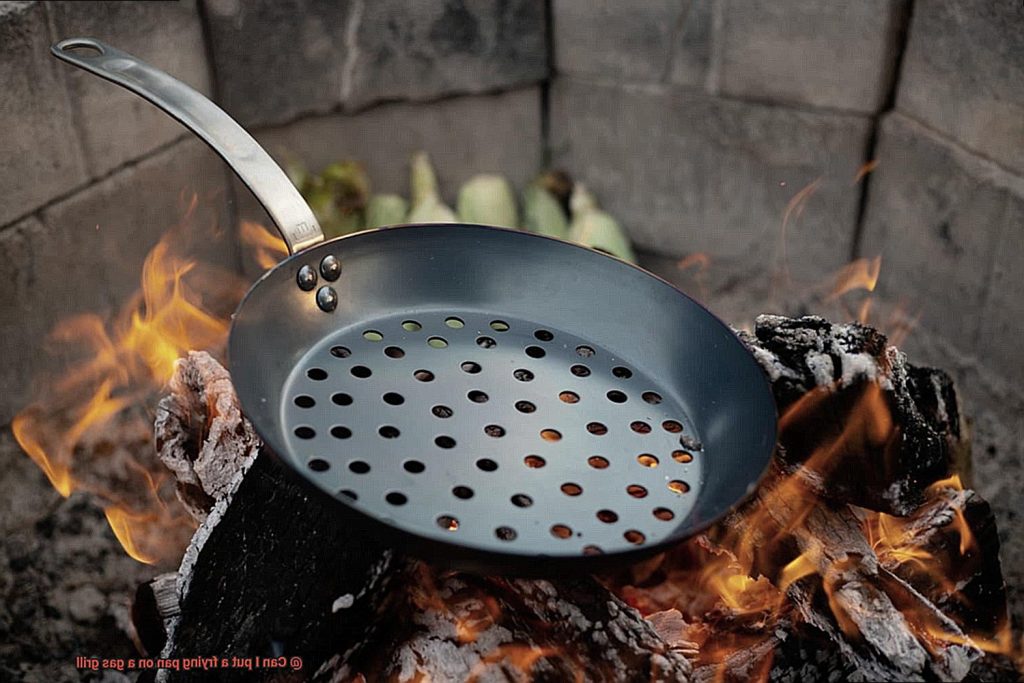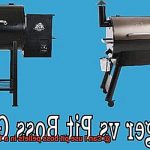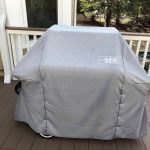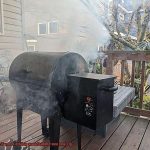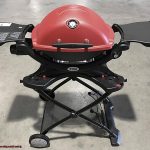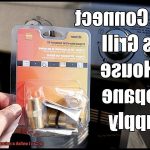Do you love the idea of cooking outside on your gas grill but hate being confined to grilling only? Why not try using a frying pan on your gas grill? It’s a great way to add variety to your outdoor cooking routine and enjoy the fresh air at the same time. But before you get started, there are a few things you need to know.
The question of whether or not you can put a frying pan on a gas grill is one that many people ask. The answer isn’t straightforward, as it depends on several factors. For example, the type of gas grill you have, the material of your frying pan, and how evenly your grill distributes heat all play a role.
In this blog post, we’ll dive into everything you need to know about using a frying pan on a gas grill. We’ll discuss the benefits and drawbacks of this cooking method, explore different types of frying pans that work well with gas grills, and provide essential safety tips for grilling with a frying pan.
Whether you’re an experienced griller or just starting out, this post is for you. So sit back, relax, and let’s explore how to take your outdoor cooking game to new heights.
Contents
What Kind of Frying Pan is Best for a Gas Grill?
If you’re thinking about using a frying pan on your gas grill, it’s important to choose the best one for the job. Not all frying pans are created equal, and some may not be suitable for use on a gas grill. Here are some important factors to consider:
- Material Matters: When selecting a frying pan for your gas grill, opt for materials that can withstand high temperatures. Cast iron is an excellent choice, as it can handle high heat without warping or cracking. Stainless steel is another good option, as it is also durable and can handle high temperatures.
- Flat Bottoms Rule: Choose a frying pan with a flat bottom to ensure even heat distribution. This will help the pan sit evenly on the grill grates and prevent hot spots from forming.
- Size Matters: Pick a frying pan that is slightly smaller than the cooking area of your grill to allow for proper ventilation. This will prevent the pan from blocking airflow and ensure your food cooks evenly.
- Lid It Up: Consider purchasing a frying pan with a lid. A lid will help to trap heat and smoke inside the pan, allowing for more flavorful cooking and preventing flare-ups.
- Preheat Properly: Before placing the frying pan on the grill, preheat it for at least 10-15 minutes. Lightly oil the pan to prevent sticking and promote browning.
- Keep an Eye on Your Food: When using a frying pan on a gas grill, keep an eye on your food and adjust the temperature as needed. Gas grills can get very hot, so monitoring the heat is crucial to prevent burning or overcooking.
Preheating the Frying Pan Before Cooking
Don’t underestimate the power of preheating your frying pan before cooking on a gas grill. It’s a crucial step that can make or break your dish, impacting its flavor and texture.
To achieve the perfect sear and ensure even cooking, follow these essential tips for preheating your frying pan on a gas grill:
Temperature Control: Start by heating up your grill to the desired temperature. Turn all burners on high and close the lid for 10-15 minutes, allowing heat to distribute evenly throughout the grill.
Choosing the Right Pan: Not all frying pans are created equal when it comes to grilling. Cast iron pans are durable and can withstand high temperatures without warping or cracking. Meanwhile, non-stick pans should be avoided as they can release harmful chemicals when exposed to high heat.
Preheating Time: Once your grill has reached maximum temperature, place your frying pan on the grates and let it preheat for a few minutes. This will ensure that the pan is evenly heated and ready for cooking.
Adding Oil or Butter: Before adding any food to your frying pan, add some oil or butter to prevent sticking and ensure even cooking.
Oiling the Frying Pan Before Adding Food
When it comes to cooking on a gas grill, oiling your frying pan is a crucial step in ensuring your food cooks evenly and doesn’t stick to the pan. But it’s not just a matter of pouring any old oil into the pan. To get the best results, you need to follow a few simple steps.
First and foremost, choose an oil with a high smoke point. Canola and vegetable oil are great options as they can withstand high temperatures without burning. On the other hand, butter or olive oil have lower smoke points and can easily burn, so avoid using them.
Once you have your oil of choice, pour a small amount into the pan and spread it evenly across the surface using a brush or paper towel. Don’t forget to coat the sides of the pan too. This thin layer of oil will act as a barrier between your food and the pan, preventing sticking and ensuring even cooking.
Next, preheat your pan on the gas grill for a few minutes before adding your food. This will allow the oil to heat up and create a non-stick surface for your food to cook on. When adding food to the hot oiled frying pan on the gas grill, be sure to do so gently and in a single layer. Overcrowding the pan can cause your food to steam rather than fry, resulting in uneven cooking and soggy food.
To sum it up, here are the steps you should follow:
- Choose an oil with a high smoke point
- Pour a small amount into the pan and spread it evenly across the surface (including the sides)
- Preheat your pan on the gas grill for a few minutes before adding your food
- Add your food gently and in a single layer
Adjusting the Temperature on Your Gas Grill
Grilling is an art form, and like any other craft, it takes time to master. As a grill master, one of the most critical skills you need to develop is the ability to adjust the temperature on your gas grill. This skill is particularly crucial when using a frying pan on the grill. Fear not. With this guide, you’ll learn how to adjust your grill’s temperature with ease and cook up some scrumptious meals in no time.
Firstly, let’s delve into the basics of how a gas grill works. Most gas grills have multiple burners that can be controlled by knobs on the front of the grill. Each burner heats a different area of the grill, allowing you to create various heat zones. This is vital when using a frying pan on the grill because you want to make sure that your food cooks evenly and doesn’t burn.
To adjust the temperature on your gas grill, begin by preheating it for at least 10-15 minutes with all burners on high. This ensures that your grill is hot enough to cook your food correctly. Once it’s hot, turn off one or more burners as needed to achieve your desired temperature. If you’re using a frying pan on the grill, keep the burner directly under the pan on medium-high heat and turn off any adjacent burners.
It’s important to note that external factors such as wind, altitude and outside temperature can affect the temperature of your grill. In windy conditions, you may need to increase the heat slightly to compensate for the loss of heat caused by the wind. Similarly, if you’re cooking at a high altitude or in cold weather, you may need to increase the heat as well.
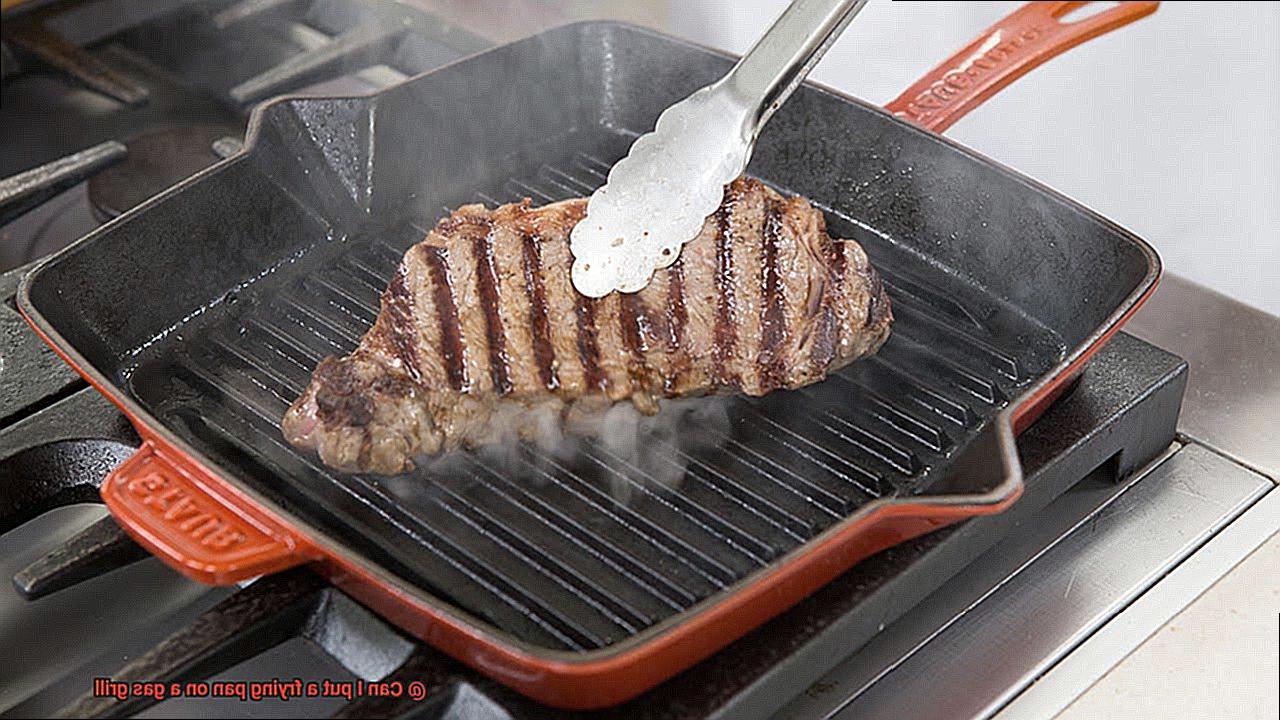
Here are a few more tips to help you adjust the temperature on your gas grill like a pro:
- Use an instant-read thermometer to check the internal temperature of your food.
- Keep a spray bottle filled with water handy to put out any flare-ups.
- Keep your grill clean to prevent flare-ups and uneven heating.
Benefits of Using a Frying Pan on a Gas Grill
Look no further than using a frying pan on your gas grill. This technique offers a variety of benefits that can enhance your outdoor cooking experience.
First and foremost, using a frying pan on your gas grill provides versatility. Say goodbye to boring burgers and hot dogs – with a frying pan, you can cook a wide range of foods, from crisp veggies to juicy seafood to succulent meats. This opens up a whole new world of grilling possibilities and allows you to get creative with your menu.
Not only does using a frying pan expand your cooking options, but it also provides even cooking. The flat surface of the pan distributes heat evenly, ensuring consistent cooking throughout your food. No more overcooked or undercooked pieces – just perfectly cooked meals every time. This is especially useful for delicate foods that might fall apart on the grill grates.
Another benefit is reduced mess. Drippings and juices from your food are caught in the pan, preventing them from falling through the grates and causing flare-ups. This not only makes cleanup easier but also reduces the risk of burning your food. Plus, you can use those flavorful drippings to make delicious sauces or gravies.
Speaking of cleaning up, using a frying pan is also more convenient than cleaning grill grates. Simply remove the pan from the grill and wash it like any other dish. No need to spend hours scrubbing away at stubborn grill grime. And if you’re short on space, you can use disposable aluminum pans for even easier cleanup.
And lastly, using a frying pan on your gas grill allows for healthier cooking options. You have better control over the amount of oil or butter you use, resulting in lower-fat meals for those watching their diet. Plus, by using fresh ingredients and avoiding processed foods, you can create nutritious meals that are bursting with flavor.
Tips for Preventing Sticking and Burning
Grilling is a fantastic way to cook food, but it can be disheartening when your food sticks to the pan or burns. If you want to use a frying pan on your gas grill, there are some essential tips that can help you avoid sticking and burning.
Preheat the Grill
Before placing your frying pan on the gas grill, preheat the grill for at least 10-15 minutes. A hot grill creates a non-stick surface that prevents food from sticking to the pan and ensures even cooking.
Oil Your Pan
To prevent sticking, add a thin layer of oil to the frying pan before placing it on the grill. High smoke point oils like canola, vegetable, or peanut oil are ideal for this purpose since they don’t burn quickly.
Choose the Right Pan
Choosing the right frying pan for your gas grill is crucial. Heavy-bottomed pans with flat surfaces can withstand high heat without warping or melting, making them ideal for grilling.
Don’t Overcrowd the Pan
Overcrowding the pan can cause food to steam instead of cooking correctly, leading to sticking and unevenly cooked dishes. To avoid this, make sure there is enough space between each piece of food in the pan for even cooking and easy flipping.
Use a Timer
It’s easy to get distracted while grilling, but setting a timer can help prevent overcooking or burning your food. Be sure to keep an eye on the heat and adjust it as necessary to prevent burning.
How to Monitor Your Food While Grilling with a Frying Pan
Grilling with a frying pan on a gas grill is a great way to cook food outdoors. However, it’s important to monitor your food closely to avoid any mishaps.
Choosing the Right Frying Pan
Cast iron or stainless steel pans are recommended for high-temperature cooking as they can withstand the heat. Avoid non-stick pans as they can release harmful chemicals when exposed to high temperatures.
Preheating the Pan
Before placing the frying pan on the grill, preheat it for at least 10-15 minutes. This will ensure that the pan is hot enough to cook your food evenly. Lightly oil the pan to prevent sticking and promote browning.
Monitoring Your Food
Use a thermometer or timer to monitor your food carefully. Insert the thermometer into the thickest part of the food to ensure it reaches the desired temperature. Set a timer for the recommended cooking time and check your food periodically.
Heat Distribution
Gas grills have hot spots, so move your food around the pan and adjust the heat as needed. Using a lid over the frying pan can help trap heat and cook the food evenly. Keep an eye on the temperature gauge on your grill and adjust the heat accordingly.
Handling Your Food
It’s essential to use tongs or a spatula when handling your food on the grill. Avoid using a fork as piercing the food can cause juices to escape, leading to dry and tough meat.
Cleaning and Storing Your Frying Pan After Use
Cleaning and storing your frying pan after use is not only important for maintaining its quality, but it can also ensure that it lasts for years to come. After all, no one wants to cook on a dirty pan. So, let’s dive into the details of how to properly care for your frying pan.
First things first, let your frying pan cool down before cleaning it. This is critical to avoid damaging the non-stick coating or warping the pan. Once it’s cool enough to handle, use a spatula or a paper towel to remove any remaining food particles.
When it comes to washing your frying pan, warm soapy water and a sponge or soft-bristled brush are your best friends. Avoid using abrasive cleaners or steel wool as they can scratch the surface of your pan. If you’re dealing with stubborn stains or burnt-on food, try soaking the frying pan in warm water and dish soap for a few minutes before washing it. You can also opt for natural cleaners like baking soda and vinegar to remove stains and odors.
After cleaning your frying pan, it’s time to dry it off thoroughly. Use a towel or let it air dry completely before storing it. It’s important to keep your frying pan in a cool, dry place away from direct sunlight and moisture. If you stack pans on top of each other, place a piece of paper towel between them to prevent scratches.
To recap, here are some tips for cleaning and storing your frying pan after use:
- Let it cool down before cleaning
- Use warm soapy water and a soft-bristled brush
- Avoid using abrasive cleaners or steel wool
- Try natural cleaners like baking soda and vinegar for stubborn stains
- Dry it thoroughly before storing
- Keep it in a cool, dry place away from moisture and sunlight
- Place a piece of paper towel between stacked pans
Also Read: Can You Add a Side Burner to a Weber Grill?
Conclusion
In conclusion, don’t limit yourself to just grilling burgers and hot dogs on your gas grill. Adding a frying pan to your outdoor cooking arsenal can elevate your meals to new heights. But before you start sizzling away, make sure you choose the right frying pan that can handle high temperatures and distribute heat evenly.
Preheating your frying pan and oiling it up are crucial steps in preventing food from sticking or burning. Keep a close eye on your food while grilling with a frying pan, adjusting the temperature as needed to avoid overcooking or burning.
Grilling with a frying pan offers numerous benefits, including versatility, convenience, reduced mess, and healthier cooking options. Plus, who doesn’t love the smoky flavor that comes from cooking outdoors?
After you’ve finished cooking up a storm, don’t forget about cleaning and storing your frying pan properly. This will help maintain its quality and ensure it lasts for many more grilling seasons to come.
So next time you fire up the gas grill, consider adding a frying pan to your setup. With these essential tips and safety measures in mind, you’ll be able to create mouth-watering meals while enjoying the great outdoors.

